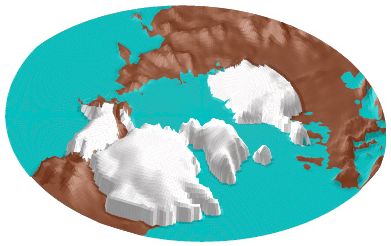November 5, 2013
Japanese Researchers Explain 100,000-year Climate Cycle and Glaciation
Keywords: Climate Change University / Research institute

Copyright Japan Agency for Marine-Earth Science and Technology All Rights Reserved.
The University of Tokyo, the Japan Agency for Marine-Earth Science and Technology (JAMSTEC), and the National Institute of Polar Research (NIPR) say they have worked out the mechanism of a 100,000-year glacial cycle and climate change connection. The discovery, posted in a scientific paper on August 8, 2013, claims that the glaciation-interglaciation cycle is generated by climatic response to insolation change and internal feedbacks between the climate, ice sheets, and the lithosphere. Taking advantage of the latest ice sheet-climate modeling, the research team ran a sophisticated simulation, which led to this first-in-the world finding.
The past million years of human evolution has seen 100,000-year glaciation-interglaciation cycles where continental ice sheets including Antarctica and Greenland grew and receded, causing the sea level to fluctuate by 130 meters or more. The mechanism underpinning this specific cycle and magnitude of change, however, has remained mystery.
The results obtained from the most recent simulations showed that some of the characteristics of the ice sheets of the North American continent allow even a small insolation shift to set off larger changes in ice sheet volume, pinning down the significant role of terrain and the climate distribution of the North American continent in triggering the glaciation cycle. They also found that carbon dioxide in the atmosphere fluctuates along with and amplifies glaciation and interglaciation alternation, but does not itself initiate the 100,000-year cycle.
This discovery will provide a significant foundation in evaluating the reliability of ice sheet-climate modeling used for predicting global warming and its long-term effects.
Related
"JFS Newsletter"
- Shaping Japan's Energy toward 2050 Participating in the Round Table for Studying Energy Situations
- Implementation of the Paris Climate Agreement: A Report on Japan's Round Table for Studying Energy Situations
- Auto Sales Industry Cooperates to Tackle Social Responsibility: Examples from Yamagata, Japan
- Yokohama FC: Leader in Eco-Activities through Football-Related Carbon Offset
Related
"Popular Articles"
- Large Ozone Hole Observed Again in 2011
- Japan's Pro Baseball Teams Start Eco-Project to Cut Energy Use by 6%
- Manufacturer Saving Energy by Growing Vertical Gardens on Factory Walls
- Sony Draws Up 'Road to Zero' Plan for Zero Environmental Footprint
- Tokyo Announces Innovative 10-Year Strategy against Climate Change


